gas type TOYOTA RAV4 PRIME 2021 Owners Manual (in English)
[x] Cancel search | Manufacturer: TOYOTA, Model Year: 2021, Model line: RAV4 PRIME, Model: TOYOTA RAV4 PRIME 2021Pages: 616, PDF Size: 34.66 MB
Page 114 of 616
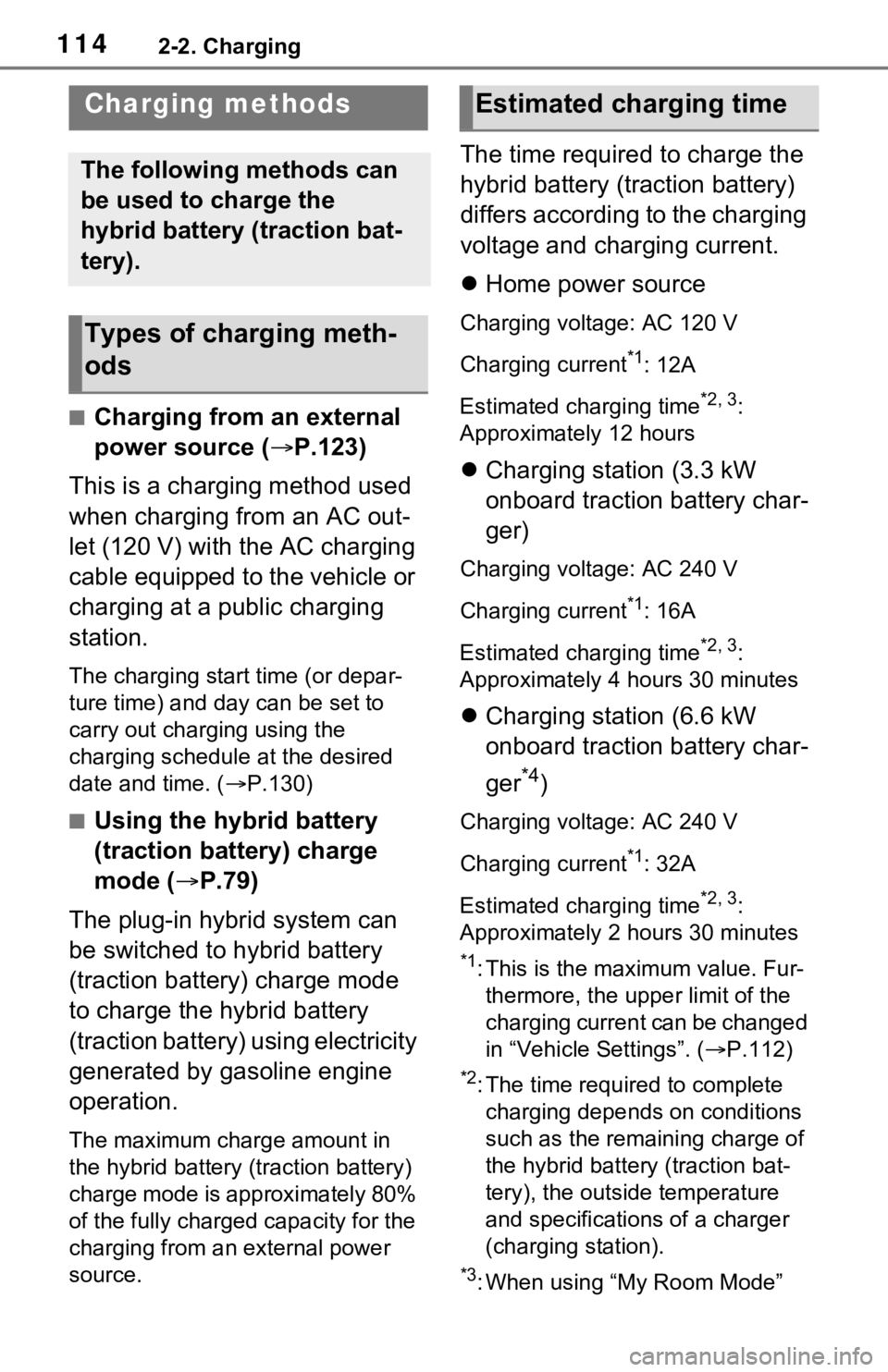
1142-2. Charging
■Charging from an external
power source (P.123)
This is a charging method used
when charging from an AC out-
let (120 V) with the AC charging
cable equipped to the vehicle or
charging at a public charging
station.
The charging start time (or depar-
ture time) and day can be set to
carry out charging using the
charging schedule at the desired
date and time. ( P.130)
■Using the hybrid battery
(traction battery) charge
mode ( P.79)
The plug-in hybrid system can
be switched to hybrid battery
(traction battery) charge mode
to charge the hybrid battery
(traction battery) using electricity
generated by gasoline engine
operation.
The maximum charge amount in
the hybrid battery (traction battery)
charge mode is approximately 80%
of the fully charged capacity for the
charging from an external power
source.
The time required to charge the
hybrid battery (traction battery)
differs according to the charging
voltage and charging current.
Home power source
Charging voltage: AC 120 V
Charging current
*1: 12A
Estimated charging time
*2, 3:
Approximately 12 hours
Charging station (3.3 kW
onboard traction battery char-
ger)
Charging voltage: AC 240 V
Charging current
*1: 16A
Estimated charging time
*2, 3:
Approximately 4 hours 30 minutes
Charging station (6.6 kW
onboard traction battery char-
ger
*4)
Charging voltage: AC 240 V
Charging current
*1: 32A
Estimated charging time
*2, 3:
Approximately 2 hours 30 minutes
*1: This is the maximum value. Fur- thermore, the upper limit of the
charging current can be changed
in “Vehicle Settings”. ( P.112)
*2: The time required to complete
charging depends on conditions
such as the remaining charge of
the hybrid battery (traction bat-
tery), the outside temperature
and specifications of a charger
(charging station).
*3: When using “My Room Mode”
Charging methods
The following methods can
be used to charge the
hybrid battery (traction bat-
tery).
Types of charging meth-
ods
Estimated charging time
Page 306 of 616
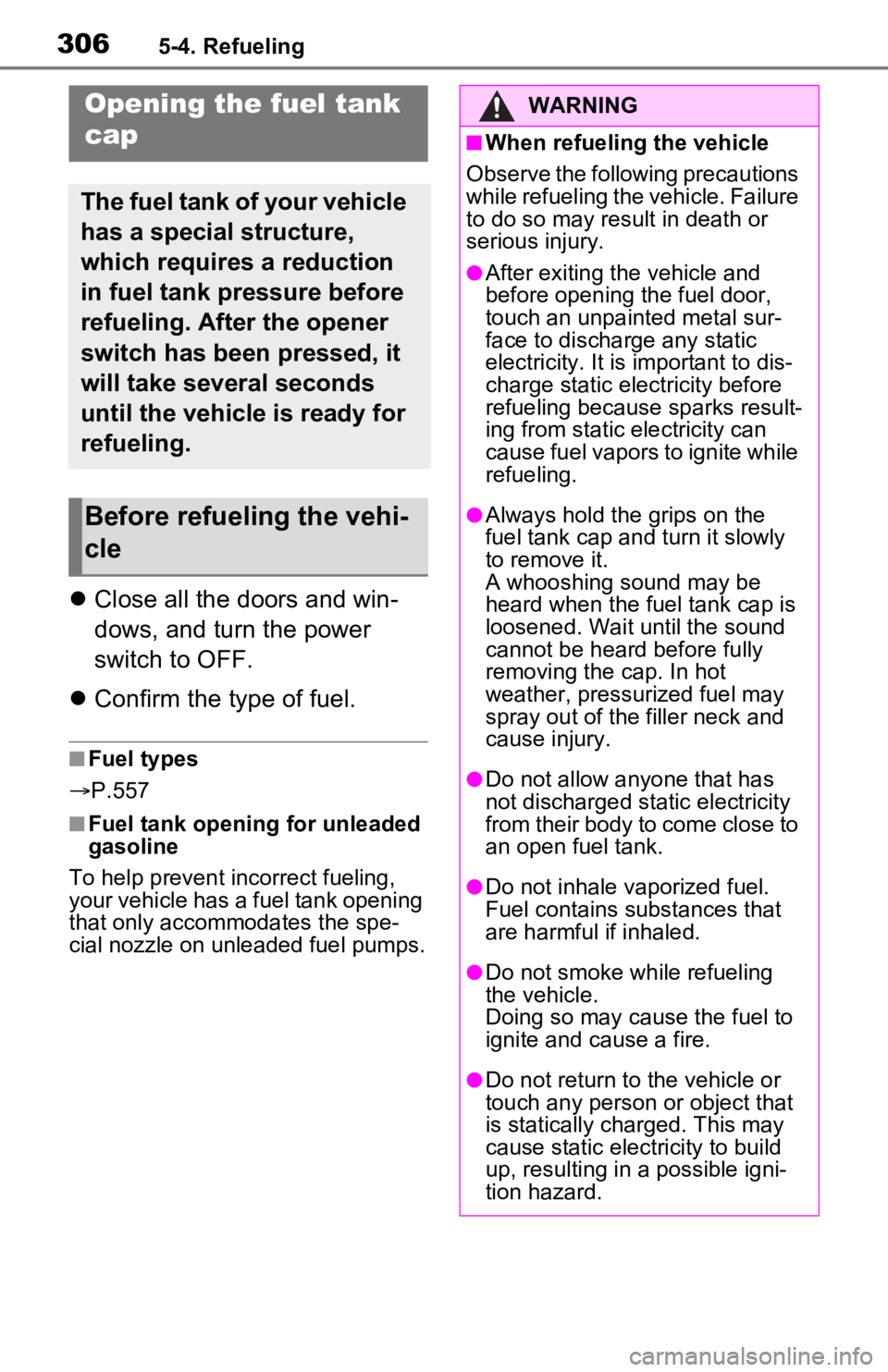
3065-4. Refueling
5-4.Refueling
Close all the doors and win-
dows, and turn the power
switch to OFF.
Confirm the type of fuel.
■Fuel types
P.557
■Fuel tank opening for unleaded
gasoline
To help prevent incorrect fueling,
your vehicle has a fuel tank opening
that only accommodates the spe-
cial nozzle on unle aded fuel pumps.
Opening the fuel tank
cap
The fuel tank of your vehicle
has a special structure,
which requires a reduction
in fuel tank pressure before
refueling. After the opener
switch has been pressed, it
will take several seconds
until the vehicle is ready for
refueling.
Before refueling the vehi-
cle
WARNING
■When refueling the vehicle
Observe the following precautions
while refueling the vehicle. Failure
to do so may result in death or
serious injury.
●After exiting the vehicle and
before opening the fuel door,
touch an unpainted metal sur-
face to discharge any static
electricity. It is important to dis-
charge static electricity before
refueling because sparks result-
ing from static electricity can
cause fuel vapors to ignite while
refueling.
●Always hold the grips on the
fuel tank cap and turn it slowly
to remove it.
A whooshing sound may be
heard when the f uel tank cap is
loosened. Wait until the sound
cannot be heard before fully
removing the cap. In hot
weather, pressurized fuel may
spray out of the filler neck and
cause injury.
●Do not allow anyone that has
not discharged static electricity
from their body to come close to
an open fuel tank.
●Do not inhale vaporized fuel.
Fuel contains substances that
are harmful if inhaled.
●Do not smoke while refueling
the vehicle.
Doing so may cause the fuel to
ignite and cause a fire.
●Do not return to the vehicle or
touch any person or object that
is statically charged. This may
cause static electricity to build
up, resulting in a possible igni-
tion hazard.
Page 425 of 616
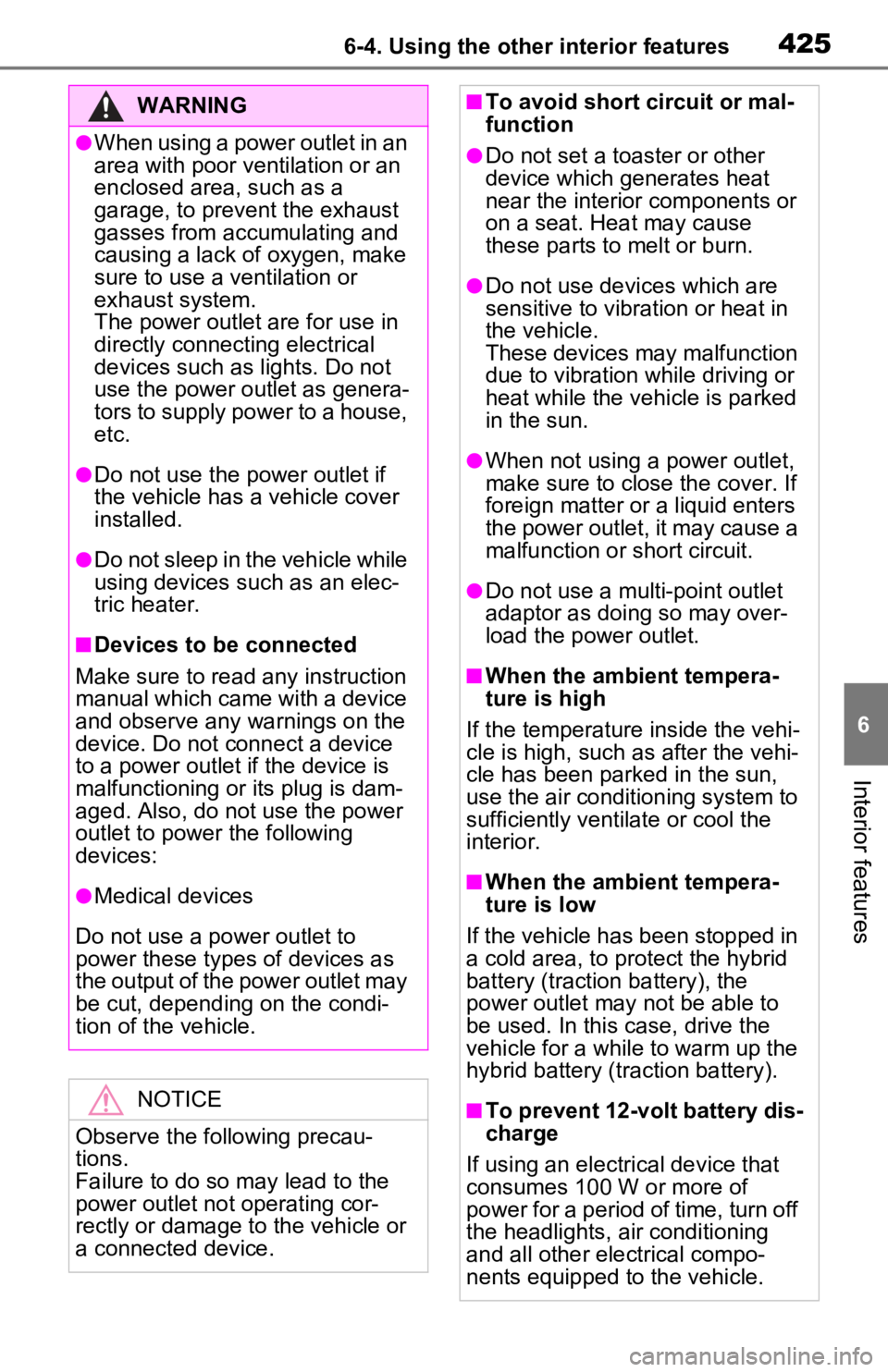
4256-4. Using the other interior features
6
Interior features
WARNING
●When using a power outlet in an
area with poor ventilation or an
enclosed area, such as a
garage, to prevent the exhaust
gasses from accumulating and
causing a lack of oxygen, make
sure to use a ventilation or
exhaust system.
The power outlet are for use in
directly connecting electrical
devices such as lights. Do not
use the power outlet as genera-
tors to supply power to a house,
etc.
●Do not use the p ower outlet if
the vehicle has a vehicle cover
installed.
●Do not sleep in the vehicle while
using devices such as an elec-
tric heater.
■Devices to be connected
Make sure to read any instruction
manual which came with a device
and observe any warnings on the
device. Do not connect a device
to a power outlet if the device is
malfunctioning or its plug is dam-
aged. Also, do not use the power
outlet to power the following
devices:
●Medical devices
Do not use a power outlet to
power these types of devices as
the output of the power outlet may
be cut, depending on the condi-
tion of the vehicle.
NOTICE
Observe the following precau-
tions.
Failure to do so m ay lead to the
power outlet no t operating cor-
rectly or damage to the vehicle or
a connected device.
■To avoid short circuit or mal-
function
●Do not set a toaster or other
device which generates heat
near the interior components or
on a seat. Heat may cause
these parts to melt or burn.
●Do not use devices which are
sensitive to vibration or heat in
the vehicle.
These devices may malfunction
due to vibration while driving or
heat while the vehicle is parked
in the sun.
●When not using a power outlet,
make sure to close the cover. If
foreign matter or a liquid enters
the power outlet, it may cause a
malfunction or s hort circuit.
●Do not use a mul ti-point outlet
adaptor as doing so may over-
load the power outlet.
■When the ambient tempera-
ture is high
If the temperature inside the vehi-
cle is high, such as after the vehi-
cle has been parked in the sun,
use the air conditioning system to
sufficiently ventilate or cool the
interior.
■When the ambient tempera-
ture is low
If the vehicle has been stopped in
a cold area, to pro tect the hybrid
battery (traction battery), the
power outlet may not be able to
be used. In this case, drive the
vehicle for a while to warm up the
hybrid battery (traction battery).
■To prevent 12-volt battery dis-
charge
If using an electrical device that
consumes 100 W or more of
power for a period of time, turn off
the headlights, air conditioning
and all other electrical compo-
nents equipped to the vehicle.
Page 448 of 616
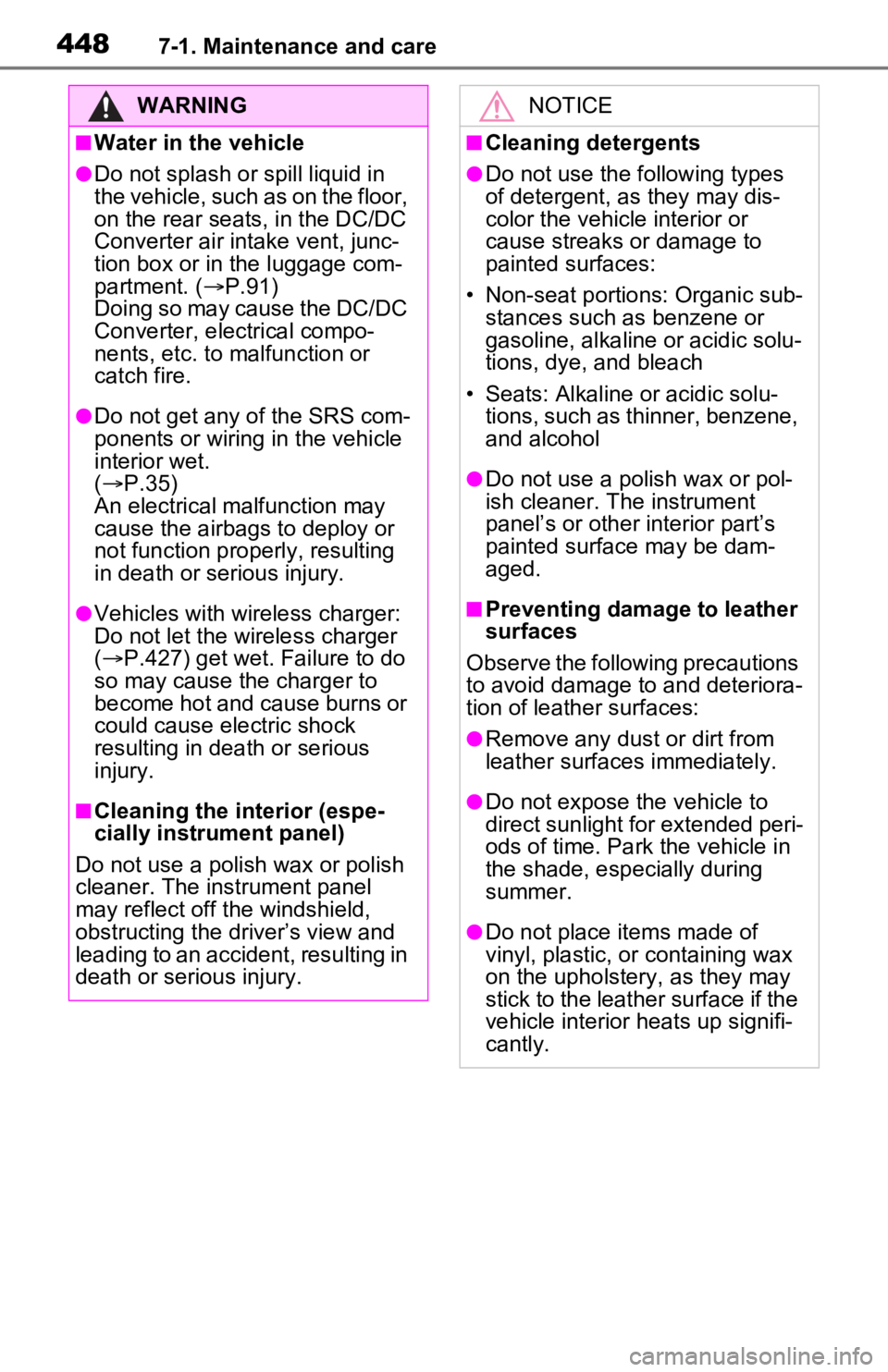
4487-1. Maintenance and care
WARNING
■Water in the vehicle
●Do not splash or spill liquid in
the vehicle, such as on the floor,
on the rear seats, in the DC/DC
Converter air intake vent, junc-
tion box or in the luggage com-
partment. (P.91)
Doing so may cause the DC/DC
Converter, electrical compo-
nents, etc. to malfunction or
catch fire.
●Do not get any of the SRS com-
ponents or wiring in the vehicle
interior wet.
( P.35)
An electrical malfunction may
cause the airbags to deploy or
not function properly, resulting
in death or serious injury.
●Vehicles with wireless charger:
Do not let the wireless charger
( P.427) get wet. Failure to do
so may cause the charger to
become hot and cause burns or
could cause electric shock
resulting in death or serious
injury.
■Cleaning the interior (espe-
cially instrument panel)
Do not use a polis h wax or polish
cleaner. The instrument panel
may reflect off the windshield,
obstructing the dr iver’s view and
leading to an accident, resulting in
death or serious injury.
NOTICE
■Cleaning detergents
●Do not use the following types
of detergent, as they may dis-
color the vehicle interior or
cause streaks or damage to
painted surfaces:
• Non-seat portions: Organic sub- stances such as benzene or
gasoline, alkaline or acidic solu-
tions, dye, and bleach
• Seats: Alkaline or acidic solu- tions, such as thinner, benzene,
and alcohol
●Do not use a polish wax or pol-
ish cleaner. The instrument
panel’s or other interior part’s
painted surface may be dam-
aged.
■Preventing damage to leather
surfaces
Observe the following precautions
to avoid damage to and deteriora-
tion of leather surfaces:
●Remove any dust or dirt from
leather surfaces immediately.
●Do not expose the vehicle to
direct sunlight for extended peri-
ods of time. Park the vehicle in
the shade, especially during
summer.
●Do not place items made of
vinyl, plastic, or containing wax
on the upholstery, as they may
stick to the leather surface if the
vehicle interior heats up signifi-
cantly.
Page 494 of 616
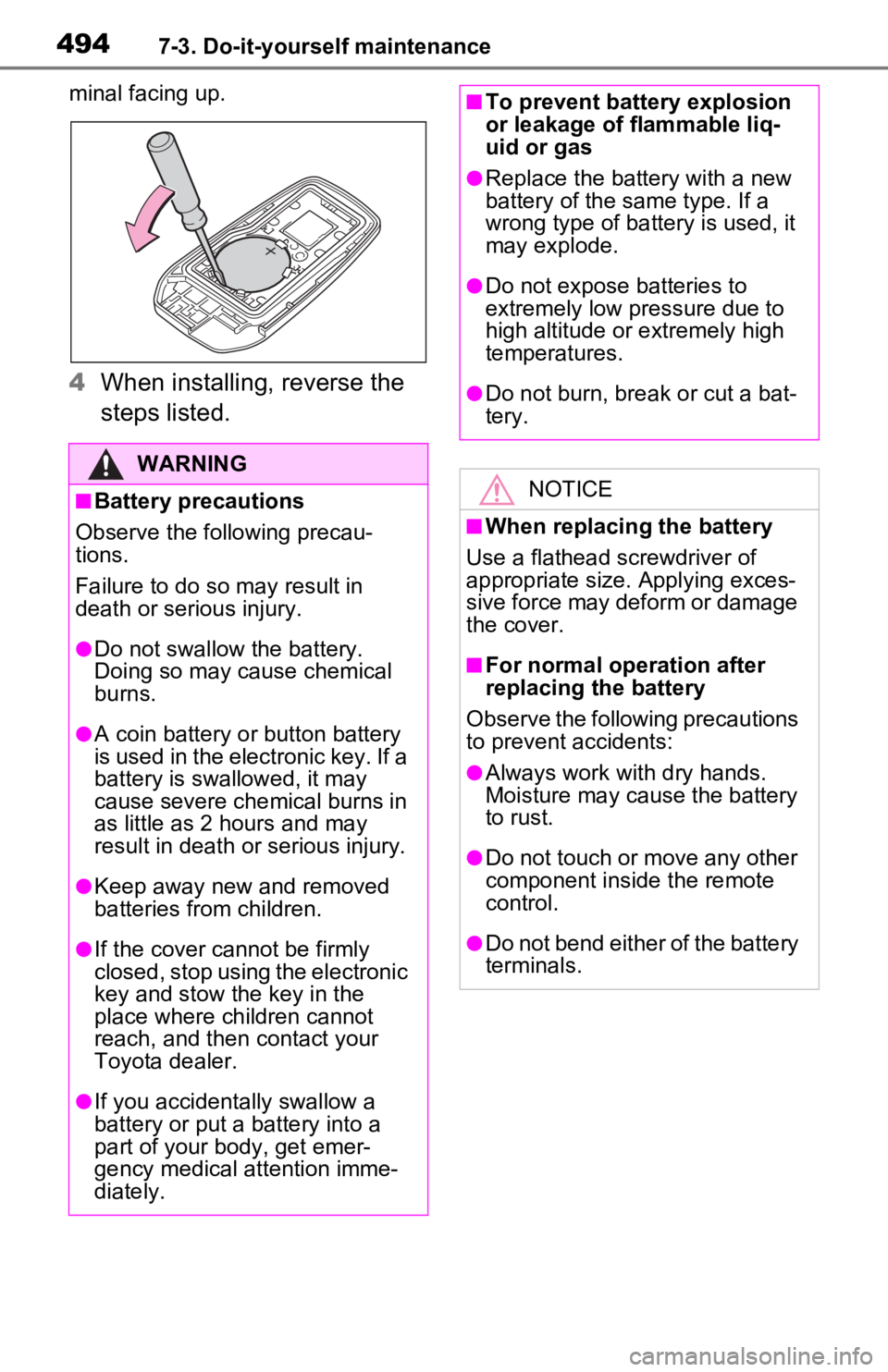
4947-3. Do-it-yourself maintenance
minal facing up.
4When installing, reverse the
steps listed.
WARNING
■Battery precautions
Observe the following precau-
tions.
Failure to do so m ay result in
death or serious injury.
●Do not swallow the battery.
Doing so may cause chemical
burns.
●A coin battery or button battery
is used in the electronic key. If a
battery is swallowed, it may
cause severe chemical burns in
as little as 2 hours and may
result in death or serious injury.
●Keep away new and removed
batteries from children.
●If the cover cannot be firmly
closed, stop using the electronic
key and stow the key in the
place where children cannot
reach, and then contact your
Toyota dealer.
●If you accidentally swallow a
battery or put a b attery into a
part of your body, get emer-
gency medical attention imme-
diately.
■To prevent battery explosion
or leakage of flammable liq-
uid or gas
●Replace the battery with a new
battery of the same type. If a
wrong type of battery is used, it
may explode.
●Do not expose batteries to
extremely low pr essure due to
high altitude or extremely high
temperatures.
●Do not burn, bre ak or cut a bat-
tery.
NOTICE
■When replacing the battery
Use a flathead screwdriver of
appropriate size. Applying exces-
sive force may deform or damage
the cover.
■For normal operation after
replacing the battery
Observe the following precautions
to prevent accidents:
●Always work with dry hands.
Moisture may cause the battery
to rust.
●Do not touch or move any other
component inside the remote
control.
●Do not bend either of the battery
terminals.
Page 551 of 616
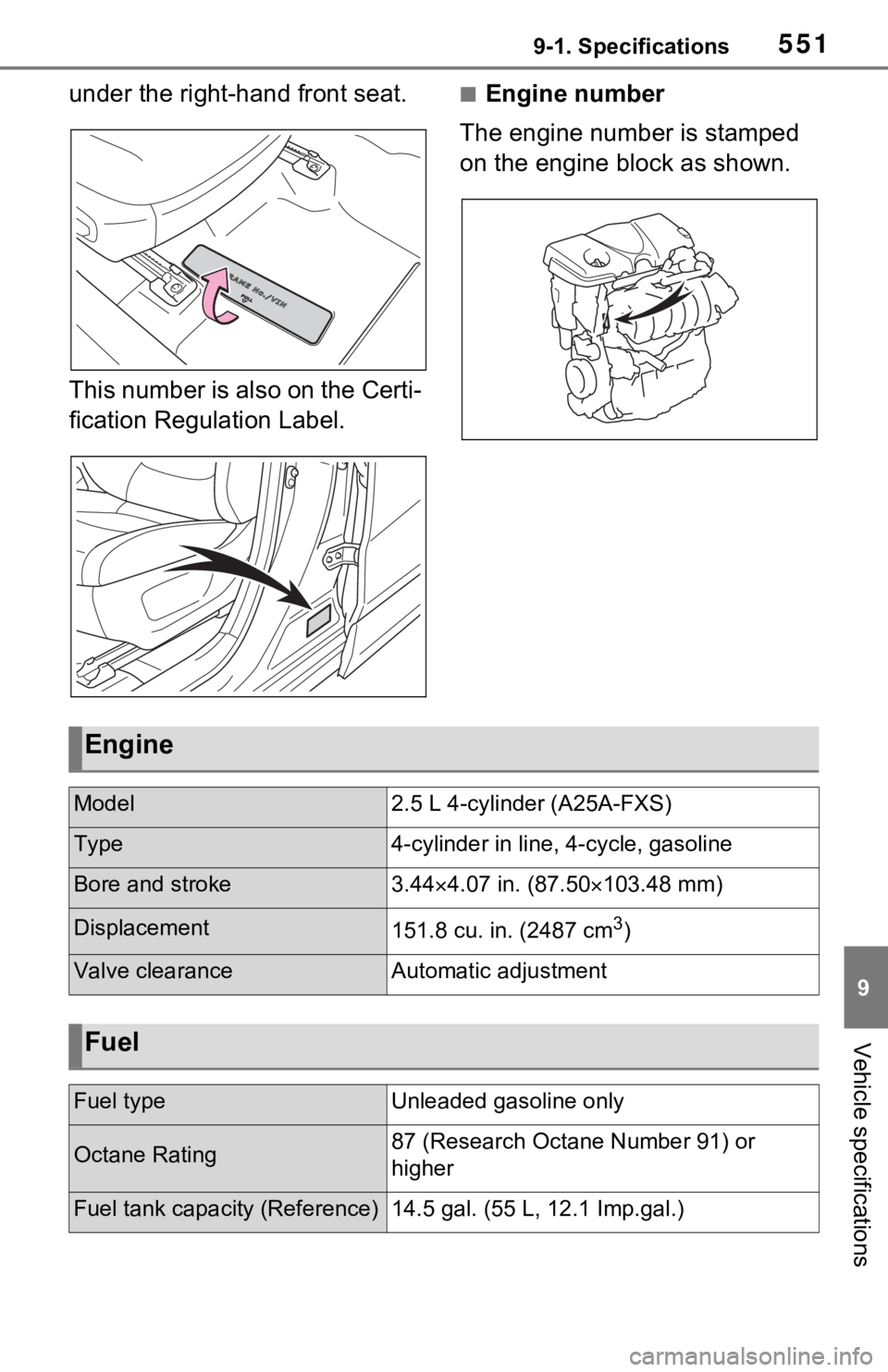
5519-1. Specifications
9
Vehicle specifications
under the right-hand front seat.
This number is also on the Certi-
fication Regulation Label.■Engine number
The engine number is stamped
on the engine block as shown.
Engine
Model2.5 L 4-cylinder (A25A-FXS)
Type4-cylinder in line , 4-cycle, gasoline
Bore and stroke3.444.07 in. (87.50 103.48 mm)
Displacement151.8 cu. in. (2487 cm3)
Valve clearanceAutomatic adjustment
Fuel
Fuel typeUnleaded gasoline only
Octane Rating87 (Research Octane Number 91) or
higher
Fuel tank capacity (Reference)14.5 gal. (55 L, 12.1 Imp.gal.)
Page 553 of 616
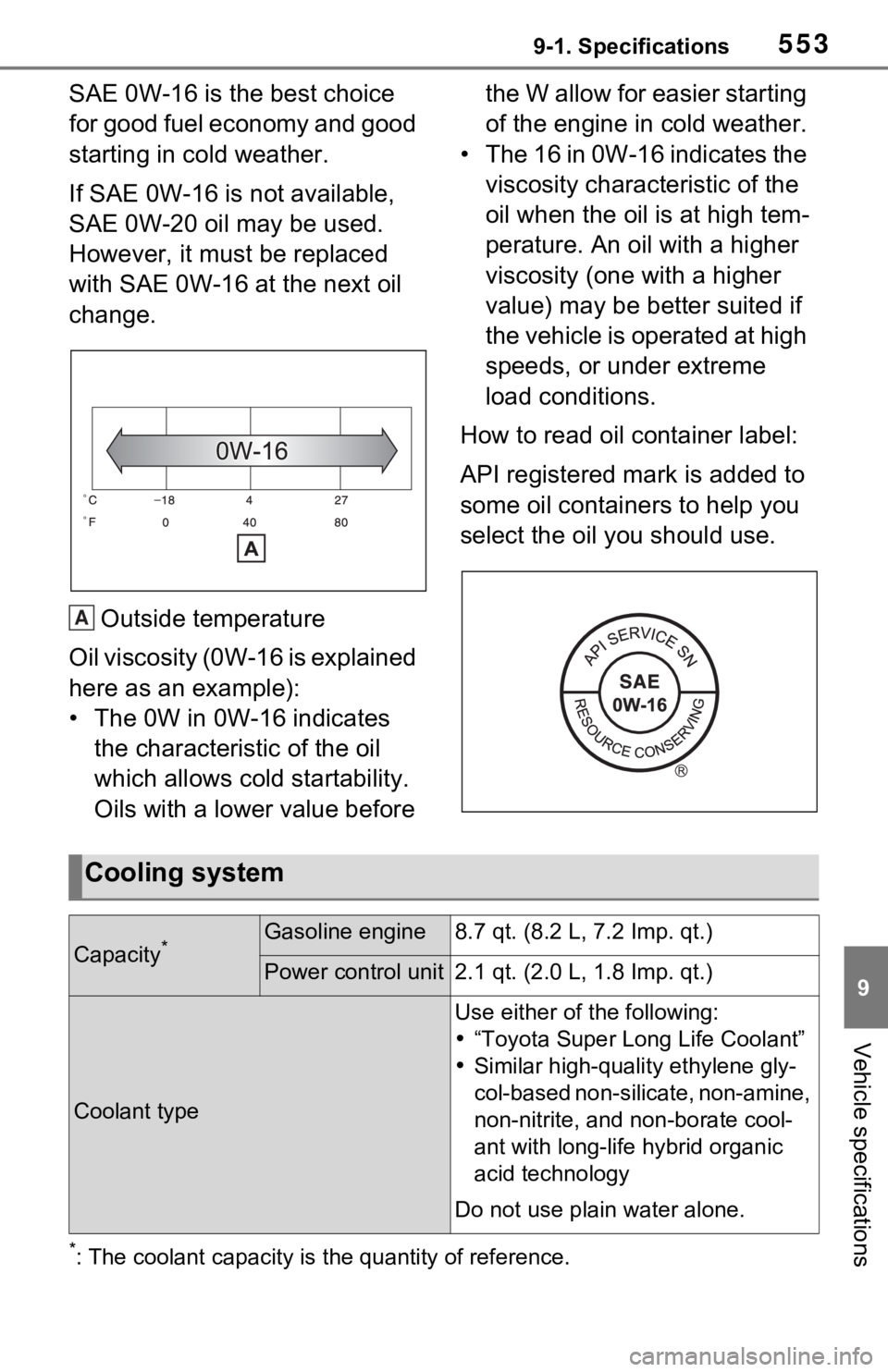
5539-1. Specifications
9
Vehicle specifications
SAE 0W-16 is the best choice
for good fuel economy and good
starting in cold weather.
If SAE 0W-16 is not available,
SAE 0W-20 oil may be used.
However, it must be replaced
with SAE 0W-16 at the next oil
change.Outside temperature
Oil viscosity (0W-16 is explained
here as an example):
• The 0W in 0W-16 indicates the characteristic of the oil
which allows cold startability.
Oils with a lower value before the W allow for easier starting
of the engine in cold weather.
• The 16 in 0W-16 indicates the viscosity characteristic of the
oil when the oil is at high tem-
perature. An oil with a higher
viscosity (one with a higher
value) may be better suited if
the vehicle is operated at high
speeds, or under extreme
load conditions.
How to read oil container label:
API registered mark is added to
some oil containers to help you
select the oil you should use.
*: The coolant capacity is the quantity of reference.
A
Cooling system
Capacity*Gasoline engine8.7 qt. (8.2 L, 7.2 Imp. qt.)
Power control unit2.1 qt. (2.0 L, 1.8 Imp. qt.)
Coolant type
Use either of the following:
“Toyota Super Long Life Coolant”
Similar high-quality ethylene gly-
col-based non-silicate, non-amine,
non-nitrite, and non-borate cool-
ant with long-life hybrid organic
acid technology
Do not use plain water alone.
Page 558 of 616

5589-1. Specifications
emission control system may be
adversely affected.
The malfunction indicator lamp on
the instrument cluster may come on.
If this happens, contact your Toyota
dealer for service.
■If your engine knocks
●Consult your Toyota dealer.
●You may occasionally notice light
knocking for a short time while
accelerating or driving uphill. This
is normal and there is no need for
concern.
NOTICE
■Notice on fuel quality
●Do not use impro per fuels. If
improper fuels are used, the
engine will be damaged.
●Do not use leaded gasoline.
Leaded gasoline can cause
damage to your vehicle’s three-
way catalytic converters caus-
ing the emission control system
to malfunction.
●Do not use gasohol other than
the type previously stated.
Other gasohol may cause fuel
system damage or vehicle per-
formance problems.
●Using unleaded gasoline with
an octane number or rating
lower than the l evel previously
stated will cause persistent
heavy knocking.
At worst, this will lead to engine
damage.
■Fuel-related poor driveability
If poor driveability (poor hot start-
ing, vaporization, engine knock-
ing, etc.) is encountered after
using a different type of fuel, dis-
continue the use of that type of
fuel.
■When refueling with gasohol
Take care not to spill gasohol. It
can damage your vehicle’s paint.
Page 604 of 616
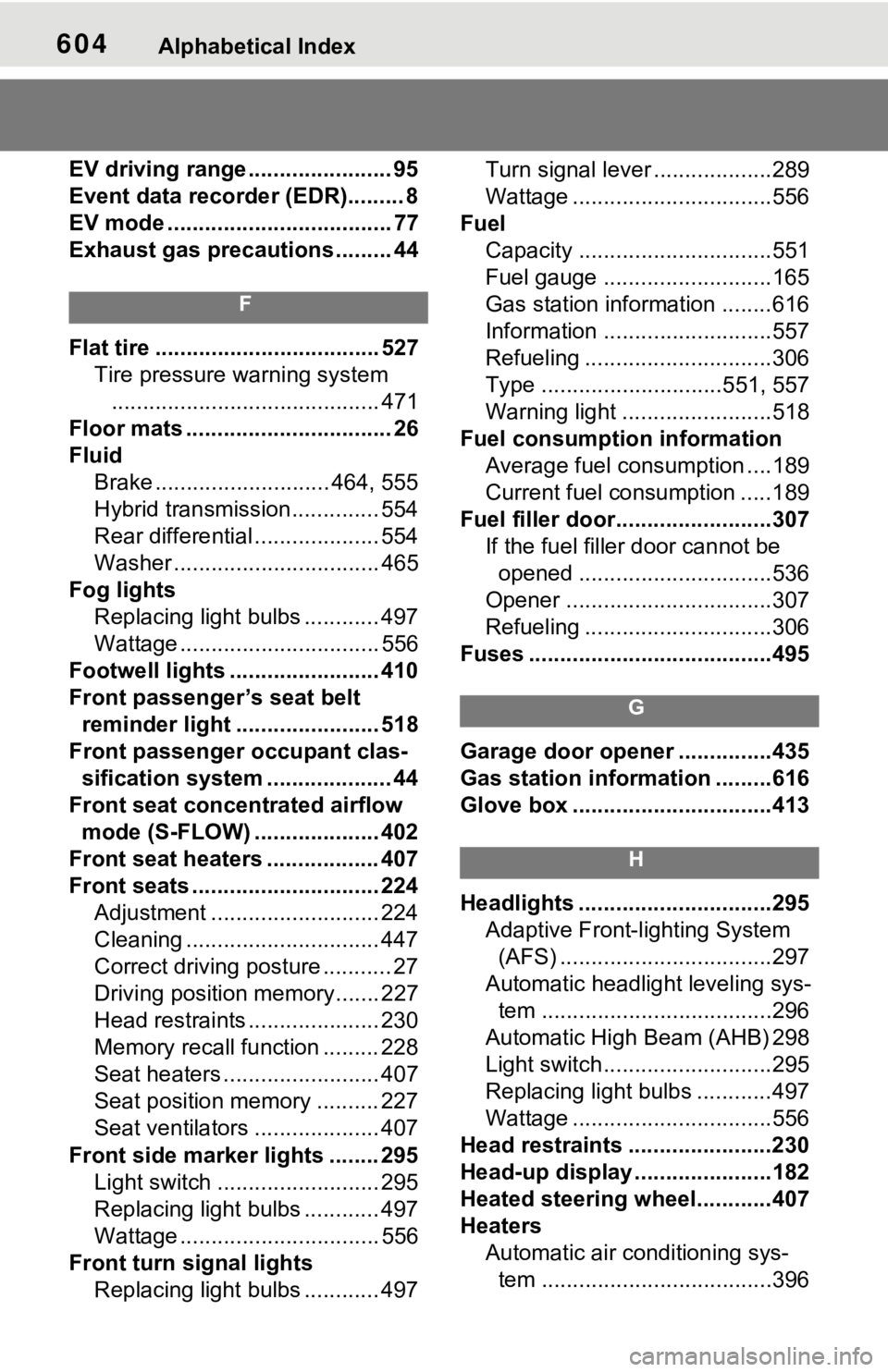
604Alphabetical Index
EV driving range ....................... 95
Event data recorder (EDR)......... 8
EV mode .................................... 77
Exhaust gas precautions ......... 44
F
Flat tire .................................... 527Tire pressure warning system........................................... 471
Floor mats ................................. 26
Fluid Brake ............................ 464, 555
Hybrid transmission.............. 554
Rear differential .................... 554
Washer ................................. 465
Fog lights Replacing light bulbs ............ 497
Wattage ................................ 556
Footwell lights ..... ................... 410
Front passenger’s seat belt reminder light ....................... 518
Front passenger occupant clas- sification system .................... 44
Front seat concentrated airflow mode (S-FLOW) .................... 402
Front seat heaters .................. 407
Front seats .............................. 224 Adjustment ........................... 224
Cleaning ............................... 447
Correct driving posture ........... 27
Driving position memory....... 227
Head restraints ..................... 230
Memory recall function ......... 228
Seat heaters ......................... 407
Seat position memory .......... 227
Seat ventilators .................... 407
Front side marker lights ........ 295 Light switch .......................... 295
Replacing light bulbs ............ 497
Wattage ................................ 556
Front turn signal lights Replacing light bulbs ............ 497 Turn signal lever .
..................289
Wattage ................................556
Fuel Capacity ...............................551
Fuel gauge ...........................165
Gas station information ........616
Information ......... ..................557
Refueling ..............................306
Type .............................551, 557
Warning light ........................518
Fuel consumption information Average fuel consumption ....189
Current fuel consumption .....189
Fuel filler door.........................307 If the fuel filler door cannot be opened ...............................536
Opener .................................307
Refueling ..............................306
Fuses .......................................495
G
Garage door opene r ...............435
Gas station information .........616
Glove box ................................413
H
Headlights ...............................295 Adaptive Front-lighting System (AFS) ..................................297
Automatic headlight leveling sys- tem .....................................296
Automatic High Beam (AHB) 298
Light switch...........................295
Replacing light bulbs ............497
Wattage ................................556
Head restraints .......................230
Head-up display ......................182
Heated steering wheel............407
Heaters Automatic air conditioning sys-tem .....................................396
Page 616 of 616

616
GAS STATION INFORMATION
Auxiliary catch lever (P.457)
Power back door switch
* ( P.207)
Fuel filler door opener switch ( P.307)
Fuel filler door ( P.307)
Tire inflation pressure ( P.555)
Hood lock release lever ( P.457)
*: Vehicles with power back door
Fuel tank capacity
(Reference)14.5 gal. (55 L, 12.1 Imp.gal.)
Fuel typeUnleaded gasoline onlyP.551
Cold tire inflation
pressureP.555
Engine oil capacity
(Drain and refill
reference)With filter
Without filter4.8 qt. (4.5 L , 4.0 Imp. qt.)
4.4 qt. (4.2 L , 3.7 Imp. qt.)
Engine oil typeP.552
A
B
C
D
E
F